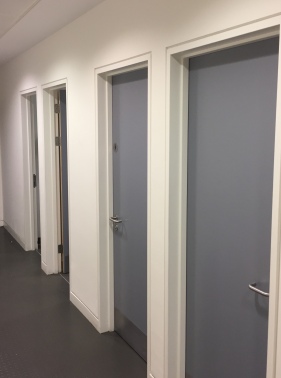
Everything we use on a daily basis from kettles and tea cups to taps and sinks to doors and handles have been designed. Someone has put time and effort into designing that object and the beauty of perfect design is you won’t even notice it. These objects of brilliant and thoughtful design are everywhere, in plain sight. They are interacted with everyday but go completely unnoticed because they are so perfectly designed and it’s utterly fascinating.

This uninspiring picture of an overly lit hallway filled with unimaginative greys and whites actually hides genius with in its mundanity. The above picture is of the toilet cubicle doors at work and they hide the most subtle and ingenious piece of design in a building filled with cutting edge tech and art. What is it? One simple thing; the handles. In particular their placement, for you see the handles to the women’s cubicles have been placed on the left hand side and those to the men on the right. So without consciousness and through repeat use users are able to determine which is the mens and which is the women’s without the ingestion of any information either from signage or reading. The door handle placement has in turn become a form of information transference and it is brilliant.
As nerdish and lame as many may see it I could talk about door design for hours or even days. That’s just about door design from the placement of handles to the type of handle and how all has been considered in order to produce a perfectly designed product. As legendary designer Don Norman, who literally wrote the book (The Design of Everyday Things), says, “A good door is a door you didn’t even know you had walked through.” Yes, there are such a thing as a good door or a bad door or as bad door is more commonly known a Norm Door, after the aforementioned Don. We’ve all encountered a bad door, have you ever tried to push a pull door or pull a push door this may not be through human error it may just in fact be a bad door. This is because it has been designed badly, so much information is communicated through design and the ability of discoverability. If we see a flat metal surface on a door we know to push simply through the power of design, this is discoverability. Vox and the 99% Invisible produced a brilliant video on this very subject and I strongly encourage you to give it a watch. If I have in anyway piqued your interest in design or even in just doors.
All of this kind of design boils down to an arm of design called Human-Centered design, this line of thinking is re-informing and improving how we design. Human-Centered design is built on a foundation of the aforementioned discoverability and feedback. Feedback here refers to a sound or a reaction we receive from using an object, the click of a mouse or the snipping of scissors, this is all regarded as feedback. Human-Centered Design begins with observation (of people or an object, etc.) before moving onto idea generation then the idea is prototyped and tested and when it ultimately fails it goes through the cycle until you are lifting your mug to your lips without thought of the design that has gone into the object you are interacting with. Perfect design. As the great film director Martin Scorcese says, “People think good editing you can see but good editing is invisible” and such a sentiment applies perfectly to design. My Grandfather, an architect, always encouraged my father to look up as they walked around the streets of London because some of the most impressive architecture is beyond the sleek modern foyer’s and bustling shop fronts. So here I reiterate to you such a sentiment and add, look for the invisible.
You’ll be amazed at what you’ll discover.